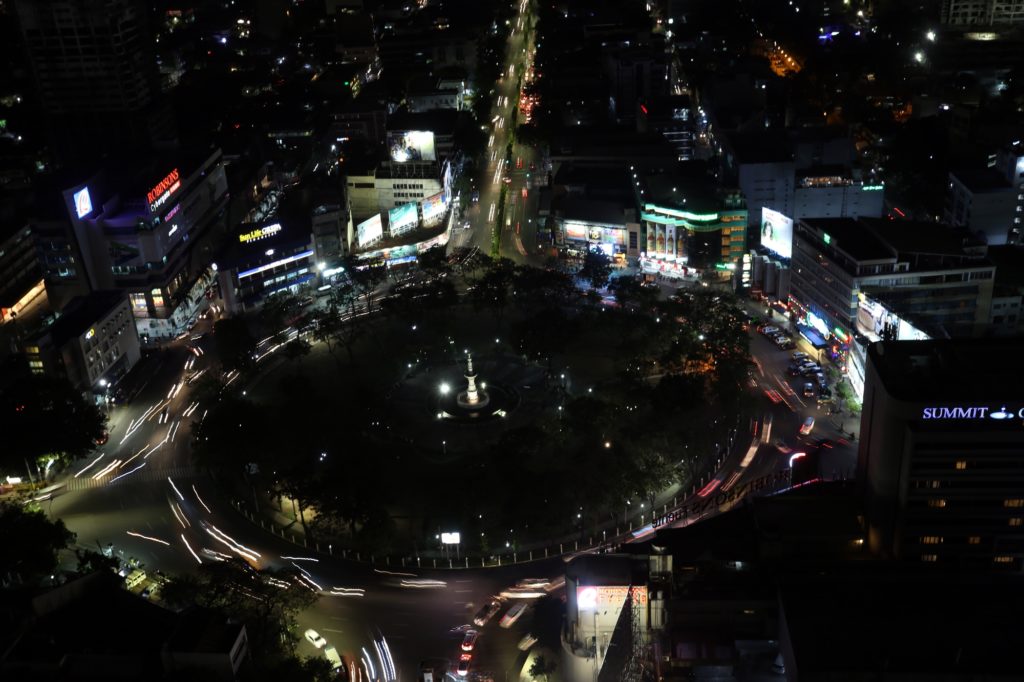
FUENTE OSMEÑA BY NIGHT IS BRT ROUTE: An areal view of Fuente Osmeña rotunda during night time. This area is part of the Bus Rapid Transit (BRT) route.(CDN PHOTO/JUNJIE MENDOZA)
Traffic jams are believed to be a sign of economic progress.
But when Metro Cebu’s worsening traffic condition becomes a daily occurrence, even that thought is not enough to ease the stress of sitting helplessly in a car or jeepney while waiting for the roads to clear.
Cebu’s booming economy is evident in the growing number of vehicles on the road and buildings being built; not to mention, a rising demand for energy from the island’s increased population.
The Philippine Statistics Authority (PSA) reports a 5.1 percent growth in Central Visayas’ Gross Regional Domestic Product (GRDP) for 2017.
And while the figure is lower than the 8.6 percent GRDP growth recorded in 2016, Central Visayas remains to be the fourth largest economy in the country next to the National Capital Region, Calabarzon, and Central Luzon.
Business, across sectors, in Cebu felt this growth; but at the same time noted that Metro Cebu’s traffic conditions had worsened.
Mandaue Chamber of Commerce and Industry (MCCI) President Stanley Go said that traffic congestion in the metropolis has affected the productivity of Cebu businesses.
“All your businesses need logistics, distribution. If you have traffic, your trucks which used to deliver to three customers, can only deliver to one,” Go explained.
And while Cebu’s increased economic activity has led to numerous opportunities, public infrastructure such as new, bigger and better roads had yet to keep up — a major blow for business.
“If your productivity is limited, your cost will be higher. You will need more trucks, more people, and you would need to buy more fuel. And with the increasing prices of fuel, it really has a huge impact on business,” added Go, who is also the vice president for sales and marketing of Virginia Foods Inc.
Aside from traffic bottlenecks and fuel price hikes, Cebu businesses also have to contend with the country’s rising inflation.
But while there is hope that the prices of oil and basic commodities will go down in the coming months — Metro Cebu’s traffic scenario remains bleak.
For the traffic problem to be solved, Go said that a lot of time was needed.
“At the end of the day, traffic is inevitable especially if there is progress and economic activity. But there should be foresight and proper planning,” he said.
Proper planning
While in other countries roads are designed to be expandable by up to four to eight more lanes, in the Philippines, roads are narrow.
Given the long and arduous process of expropriation for right-of-way acquisition, road widening often becomes a huge issue.
Cebu Business Club (CBC) President Gordon Alan Joseph, agrees that the lack of planning has greatly contributed to Cebu’s worsening traffic
condition.
Citing data from the Japan International Cooperation Agency (JICA) which initially pegged Cebu’s economic losses due to traffic at P1.1 billion a day, Joseph believed that the number could still increase.
“Can we afford this kind of traffic and this kind of non-planning? What we’re experiencing today is a result of poor planning,” he said.
Joseph, also the co-chairperson of the Metro Cebu Development and Coordinating Board (MCDCB) representing the private sector, lamented that government infrastructure projects were usually implemented without consultation.
He cited projects like the ongoing P683-million underpass in Barangay Mambaling, Cebu City criticized by business leaders for its lack of consultation resulting to monstrous traffic jams in the south district.
A similar project, the P711.8-million underpass project on U.N. Avenue, Mandaue City, is also set for implementation by the Department of Public Works and Highways in Central Visayas (DPWH-7).
Public transportation
As soon as he assumed the post early this year, newly-installed Cebu Chamber of Commerce and Industry (CCCI) President Antonio Chiu cited the traffic problem as a major concern that needed to be addressed.
Chiu is backing projects aimed to improve public transportation like the Integrated Inter-Modal Transport System (IITS) Program for Cebu planned by the Department of Transportation (DOTr).
The project involves the construction of mass transit systems such as the Cebu Bus Rapid Transit (BRT) project and a proposed light rail transit (LRT).
“This multi-faceted set of infrastructure investments when complemented with non-infrastructure initiatives can hopefully ensure the smooth flow of people, vehicles, goods, services and investments in the island of Cebu,” Chiu said.
Heavy traffic has also taken its toll on Cebu’s vibrant tourism industry with the opening of the new Terminal 2 of the Mactan Cebu International Airport (MCIA) last July.
As more international tourists are expected to visit the island, Hotels, Resorts, Restaurants, Association of Cebu (HRRAC) President Carlo Anton Suarez called on the government to immediately attend to Metro Cebu’s worsening traffic problem.
“Before, we can do city tours in one day. But now, we have to do it per area. It would be nice to have alternate routes especially on the heavy congested routes in Cebu or (see an) improvement of the traffic system,” said Suarez.